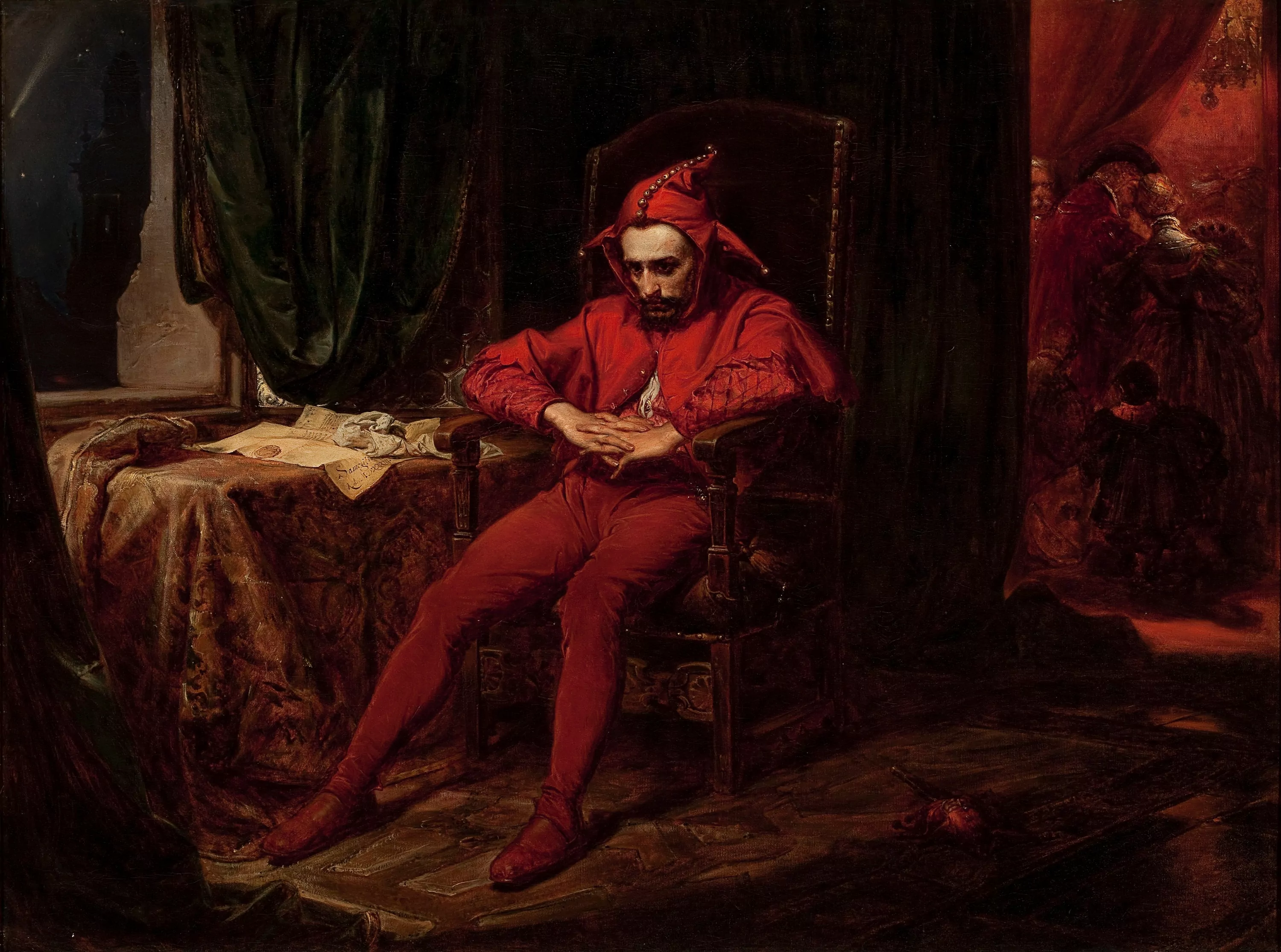


The sad clown with a painted frown is a cultural trope today, but this crimson-clad harlequin is different. Stańczyk, the renowned court jester of the Polish Renaissance sits slumped into an elegant chair that looks much too large for his small frame. His legs are kicked out and immobile, his hands clasped, his eyes glazed and distant. His three-pointed hood droops, wrinkled, and his jester’s marotte, the scepter topped with a miniature caricature of its owner, lies discarded on the floor. To his side, an unfolded letter is partially hidden under a handkerchief, and in the room behind him uproarious party-goers dance and flirt. Our red jester is a man apart, alone and haunted.
It’s a striking painting, one of the most recognizable and popular in the Warsaw National Museum, where it lives today, but it’s a rarity in the oeuvre of its artist, the Polish history painter Jan Alojzy Matejko. Matejko painted big history. Renouned for his massive canvases depicting keystone events in Polish history, Matejko loved high drama. Scenes like his Rejtan or the Battle of Grunwald give you a sense for his taste—room-sized paintings of grand, theatrical set pieces populated by dozens of recognizable politicians, generals, and kings. It’s soap opera. Stańczyk, lost in thought in a messy room, portrayed on an intimate, mid-size canvas—at first seems like an odd subject for Matejko. But there’s a lot happening in this work, let’s break it down.
Despite his penchant for bombast, Matejko was painstaking in his presentation of history, and his portrait of Stańczyk is packed with details that when put together, tell a story as sweeping as any battle scene. First, Stańczyk was no ordinary jester. Performing in the court of King Sigismund I of Poland, Stańczyk was famous for his eloquence and insight into national politics, using wit and satire to critique and inform the highest political spheres. He was a legend, and so fascinating to Matejko that the artist depicted him in two other paintings, Consecration of King Sigismund’s Bell and Prussian Homage.
The full title of the painting further clarifies the story: “Stańczyk during a ball at the court of Queen Bona in the face of the loss of Smolensk.” Smolensk was a critical trade hub for the Grand Duchy of Lithuania, the court of which Stańczyk served in. Two years into the forth Muscovite–Lithuanian War, Moscow artillery shelled the city until it surrendered, a turning point in the conflict that ended with the collapse of the Duchy of Lithuania by the end of the century.
Painting with 300 years of hindsight, Matejko packed his Stańczyk painting with dark symbolism. In the party room a lute is carried by a midget, a symbol of glory and prosperity fallen into the hands of a person of low social status. Looking closely at night sky through the window on the upper left, you can see the silhouette of Krakow’s Wawel Cathedral, the coronation site of the Polish kings, under the bad dual omens of an earthbound comet and the stars of Orions’s belt, named for a hero whose overconfidence led to his downfall by a scorpion’s sting.
The dense symbolism is a fun treasure hunt, but the real substance of the artwork is the vivid narrative created by the crumpled letter and the devastating news that only Stańczyk understands. And that is Matejko’s sleight of hand—the bombastic social drama of his typical paintings happens in the background of this one, allowing Matejko to depict the chaos and loss of a collapsing dynasty in the face of a single sad clown.
...
Got questions, comments or corrections about Stańczyk? Join the conversation in our Discord, and if you enjoy content like this, consider becoming a member for exclusive essays, downloadables, and discounts in the Obelisk Store.
